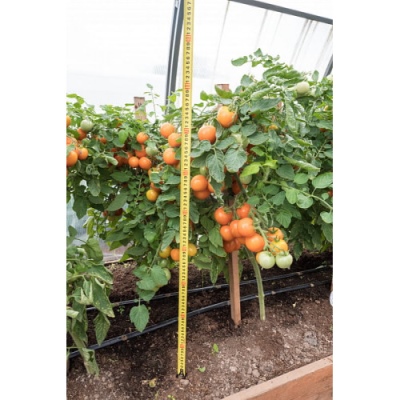
- Authors: Blokin-Mechtalin V.I.
- Year of approval: 2019
- Category: hybrid
- Growth type: determinant
- Appointment: fresh consumption
- Ripening period: early
- Ripening time, days: 85-90
- Growing conditions: for film greenhouses
- Bush height, cm: 60-70
- Leaves: short, green
Another cocktail hit - a novelty from the Farmer series, the determinant hybrid of the first generation Orange Farmer F1. Highly productive tomato is grown in glass, film, polycarbonate, heated and conventional greenhouses. The berry is characterized by a dessert taste and is used fresh and for whole-fruit canning.
Breeding history
The originator of the hybrid is V.I. Blokin-Mechtalin, the tomato was approved for use in 2019.
Description of the variety
Low-growing (60-70 cm) highly branched determinant bushes are covered with dense green foliage. The leaf plate is shortened, has a slight pubescence, a slight dissection of the edges. Flowers are collected in simple inflorescences, the first of which is laid over the 7th leaf, all subsequent ones every 2 cuttings. In clusters, up to 10 berries are formed, attached to a strong articulated stalk.
Features of the hybrid:
high decorative qualities;
early ripening and sweet taste;
unpretentiousness, productivity, strong immunity;
versatility in use, good tolerance of temperature changes.
Unfortunately, the seeds of the Orange Farmer hybrid do not retain their parental properties, this can be considered a minus.
The main qualities of the fruit
Cocktail, rounded, slightly ribbed fruits of a rich bright orange color have a mass of 45 grams, 3 centimeters in diameter.
Taste characteristics
The juicy and tender pulp is covered with a thin matte skin. Harmonious balanced taste combines sweetness with pleasant sourness. Due to the thin skin, the berry is prone to cracking; only unripe fruits are suitable for short-term storage.
Ripening and fruiting
The hybrid belongs to the early category, the berry ripening period is 85-90 days.
Yield
The tomato yield is quite attractive - from 9.4 to 10 kilograms of sweet dessert berries are harvested from 1 square meter.
The timing of planting seedlings and planting in the ground
Sowing dates are calculated depending on the region - 50 or 55 days before planting in the ground.

Growing tomato seedlings is an extremely important process, because it largely depends on whether the gardener will be able to harvest at all. All aspects must be taken into account, from seedbed preparation to planting in the ground.
Landing scheme
The optimal planting scheme for spreading bushes is no more than 5 plants per square meter, usually 4 roots are planted.

Growing and care
The orange farmer is grown in seedlings. Before transplanting into the ground, it is advisable to harden young plants for two weeks. Containers with seedlings are taken out into the street, on the balcony and loggias, on the verandas, if cold rainy weather is established.Saplings must get used to the environment, adapt to an excess of sunlight, to daily temperature changes. The soil should be fertile, pH neutral, breathable and light. If some parameters do not meet the requirements of agricultural technology, the indicators are brought to the required level.
Prepared ridges are enriched with organic matter (humus, compost, bird droppings), superphosphate and complex mineral fertilizers, 1 tbsp. tablespoons of wood ash under each root, install supports. After planting, the seedlings are well watered with warm, settled water with obligatory loosening the next day. The subsequent care of the plant is regular watering and weeding, loosening, hilling and mulching, the introduction of additional nutrients and sanitization.
The bushes need to be formed - the optimal yield is obtained when a tomato is kept in 5 stalks. The first feeding with nitrogen substances is carried out 2-3 weeks after planting. During the period of budding and ovary formation, tomatoes need phosphorus-potassium fertilizers. During the season, the hybrid can be additionally fed with infusions of mullein and nettle. The hybrid does not need pinching, but the lower leaves are removed after the formation of each brush. The plant does not have to expend energy to maintain the green mass, and it begins to more actively draw out the fruit load. After watering, it is imperative to ventilate the greenhouses, in order to avoid high humidity, which late blight loves so much.




A plant needs different micronutrients at each stage of growth. All fertilizers can be divided into two groups: mineral and organic. Folk remedies are often used: iodine, yeast, bird droppings, eggshells.
It is important to observe the rate and period of feeding. This also applies to folk remedies and organic fertilizers.
Disease and pest resistance
The tomato has excellent immunity, like most hybrids, which helps it to successfully resist fusarium and verticillosis. With late blight, everything is also quite safe, since the time of its activity comes later than the crop of the farmer ripens. Despite the good potential, experts warn: violation of the rules of agricultural technology can lead to the weakening of the plant and the appearance of symptoms of diseases. Carrying out preventive treatments with insecticides and fungicides will protect plantings from the negative effects of the environment.


Resistant to adverse weather conditions
The orange grower is resistant to sudden temperature changes.
Growing regions
The universal hybrid is successfully grown both in the warm regions of the North Caucasus, the Middle and Lower Volga, the Central Black Earth Region, the Central and Volga-Vyatka districts, and in the West Siberian, Ural, East Siberian, and Far Eastern regions.

























































































